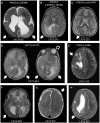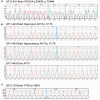PI3K/AKT pathway mutations cause a spectrum of brain malformations from megalencephaly to focal cortical dysplasia
- PMID: 25722288
- PMCID: PMC4614119
- DOI: 10.1093/brain/awv045
PI3K/AKT pathway mutations cause a spectrum of brain malformations from megalencephaly to focal cortical dysplasia
Abstract
Malformations of cortical development containing dysplastic neuronal and glial elements, including hemimegalencephaly and focal cortical dysplasia, are common causes of intractable paediatric epilepsy. In this study we performed multiplex targeted sequencing of 10 genes in the PI3K/AKT pathway on brain tissue from 33 children who underwent surgical resection of dysplastic cortex for the treatment of intractable epilepsy. Sequencing results were correlated with clinical, imaging, pathological and immunohistological phenotypes. We identified mosaic activating mutations in PIK3CA and AKT3 in this cohort, including cancer-associated hotspot PIK3CA mutations in dysplastic megalencephaly, hemimegalencephaly, and focal cortical dysplasia type IIa. In addition, a germline PTEN mutation was identified in a male with hemimegalencephaly but no peripheral manifestations of the PTEN hamartoma tumour syndrome. A spectrum of clinical, imaging and pathological abnormalities was found in this cohort. While patients with more severe brain imaging abnormalities and systemic manifestations were more likely to have detected mutations, routine histopathological studies did not predict mutation status. In addition, elevated levels of phosphorylated S6 ribosomal protein were identified in both neurons and astrocytes of all hemimegalencephaly and focal cortical dysplasia type II specimens, regardless of the presence or absence of detected PI3K/AKT pathway mutations. In contrast, expression patterns of the T308 and S473 phosphorylated forms of AKT and in vitro AKT kinase activities discriminated between mutation-positive dysplasia cortex, mutation-negative dysplasia cortex, and non-dysplasia epilepsy cortex. Our findings identify PI3K/AKT pathway mutations as an important cause of epileptogenic brain malformations and establish megalencephaly, hemimegalencephaly, and focal cortical dysplasia as part of a single pathogenic spectrum.
Keywords: brain development; childhood epilepsy; malformations of cortical development; molecular genetics.
© The Author (2015). Published by Oxford University Press on behalf of the Guarantors of Brain. All rights reserved. For Permissions, please email: journals.permissions@oup.com.
Figures








Comment in
-
The enlarging spectrum of focal cortical dysplasias.Brain. 2015 Jun;138(Pt 6):1446-8. doi: 10.1093/brain/awv098. Brain. 2015. PMID: 26013804 Free PMC article.
References
-
- Arch EM, Goodman BK, Van Wesep RA, Liaw D, Clarke K, Parsons R, et al. Deletion of PTEN in a patient with Bannayan-Riley-Ruvalcaba syndrome suggests allelism with Cowden disease. Am J Med Genet. 1997;71:489–93. - PubMed
-
- Aronica E, Boer K, Baybis M, Yu J, Crino P. Co-expression of cyclin D1 and phosphorylated ribosomal S6 proteins in hemimegalencephaly. Acta Neuropathol (Berl) 2007;114:287–93. - PubMed
-
- Backman SA, Stambolic V, Suzuki A, Haight J, Elia A, Pretorius J, et al. Deletion of Pten in mouse brain causes seizures, ataxia and defects in soma size resembling Lhermitte-Duclos disease. Nat Genet. 2001;29:396–403. - PubMed
Publication types
MeSH terms
Substances
Grants and funding
LinkOut - more resources
Full Text Sources
Other Literature Sources
Molecular Biology Databases
Research Materials
Miscellaneous

